lock TOYOTA RAV4 EV 2014 1.G Quick Reference Guide
[x] Cancel search | Manufacturer: TOYOTA, Model Year: 2014, Model line: RAV4 EV, Model: TOYOTA RAV4 EV 2014 1.GPages: 52, PDF Size: 1.69 MB
Page 36 of 52
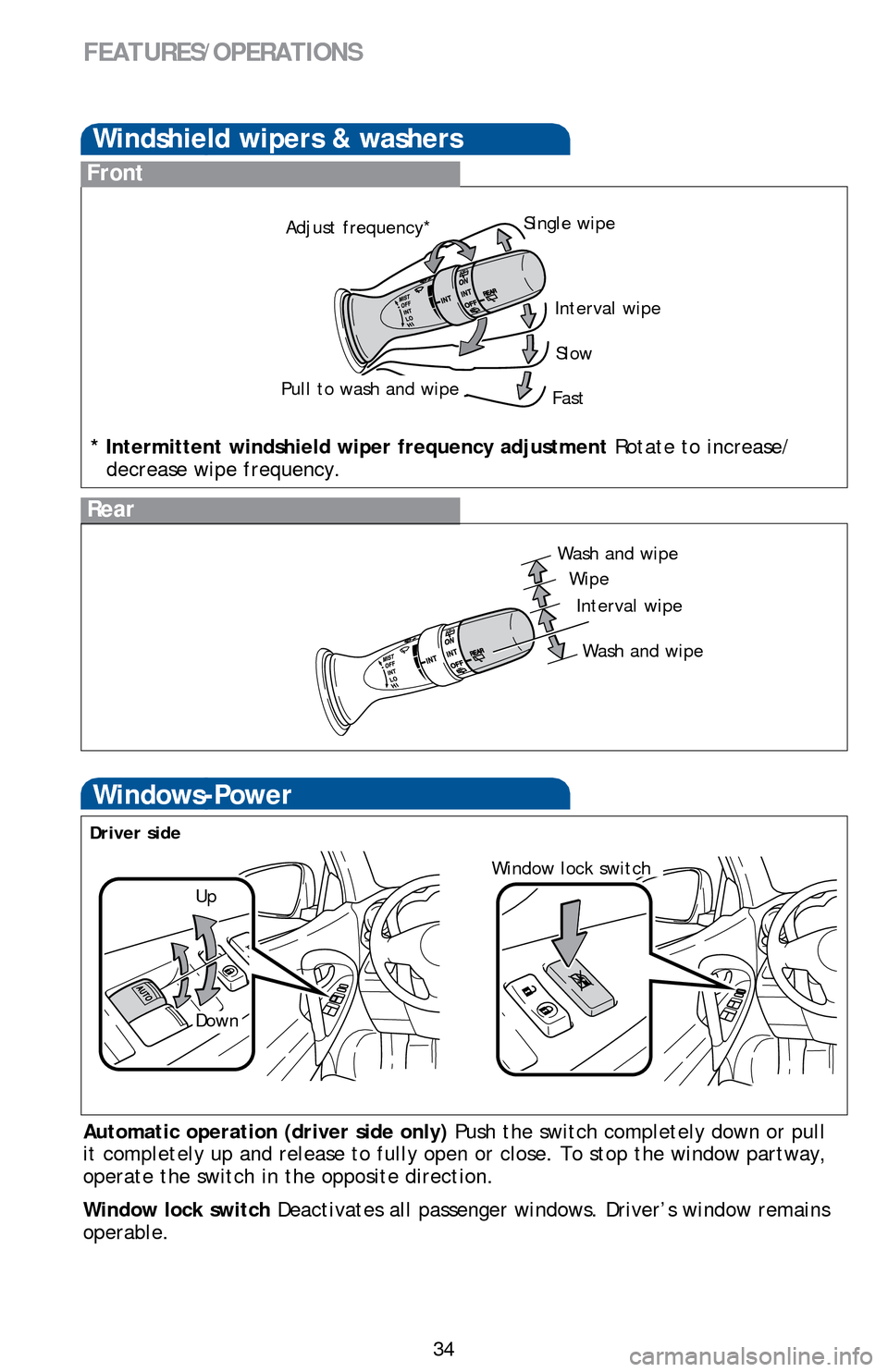
34
FEATURES/OPERATIONS
Windows-Power
Driver side
Automatic operation (driver side only) Push the switch completely down or pull
it completely up and release to fully open or close. To stop the window partway,
operate the switch in the opposite direction.
Window lock switch Deactivates all passenger windows. Driver’s window remains
operable.
Up
Down
Window lock switch
Windshield wipers & washers
Rear
Front
Pull to wash and wipeAdjust frequency*
Interval wipe
Slow
Fast
Wash and wipe
Wipe
Interval wipe
Wash and wipe Single wipe
* Intermittent windshield wiper frequency adjustment Rotate to increase/
decrease wipe frequency.
Page 37 of 52

OVERVIEW ELECTRIC VEHICLE SYSTEMFEATURES/OPERATIONS
SAFETY AND EMERGENCY FEATURES
35
Door locks
Unlock
Lock
Light control-Instrument panel
With the dial turned fully up, instrument panel lights will not dim when the
headlights are turned ON.
Brightness
control
+
-
Page 40 of 52
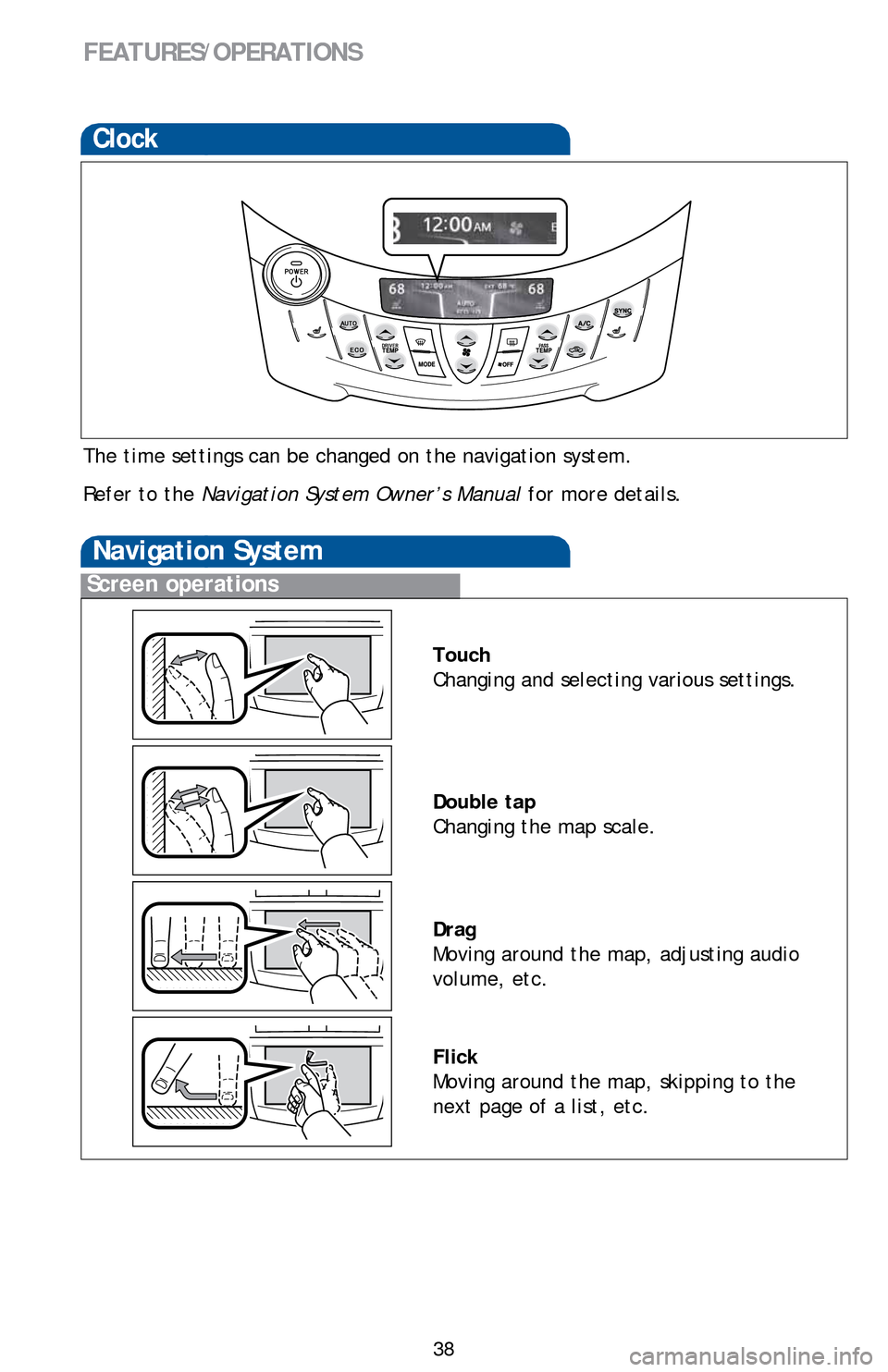
38
FEATURES/OPERATIONS
Clock
The time settings can be changed on the navigation system.
Refer to the Navigation System Owner’s Manual for more details.
Screen operations
Navigation System
Touch
Changing and selecting various settings.
Double tap
Changing the map scale.
Drag
Moving around the map, adjusting audio
volume, etc.
Flick
Moving around the map, skipping to the
next page of a list, etc.
Page 43 of 52

OVERVIEW ELECTRIC VEHICLE SYSTEMFEATURES/OPERATIONS
SAFETY AND EMERGENCY FEATURES
41
Tilt and telescopic steering wheel
Hold wheel, push lever down, set angle and length, and return lever.
NOTE: Do not attempt to adjust while the vehicle is in motion.
Lock release lever
AngleLength
Cruise control
Turning system ON/OFF
Functions
Resume2
/Increase speed
Set/Decrease speed Cancel
1
1 The set speed may also be cancelled by depressing the brake pedal.2 The set speed may be resumed once vehicle speed exceeds 25 mph.
Refer to the Owner’s Manual for more details.
System ON/OFF
Page 46 of 52
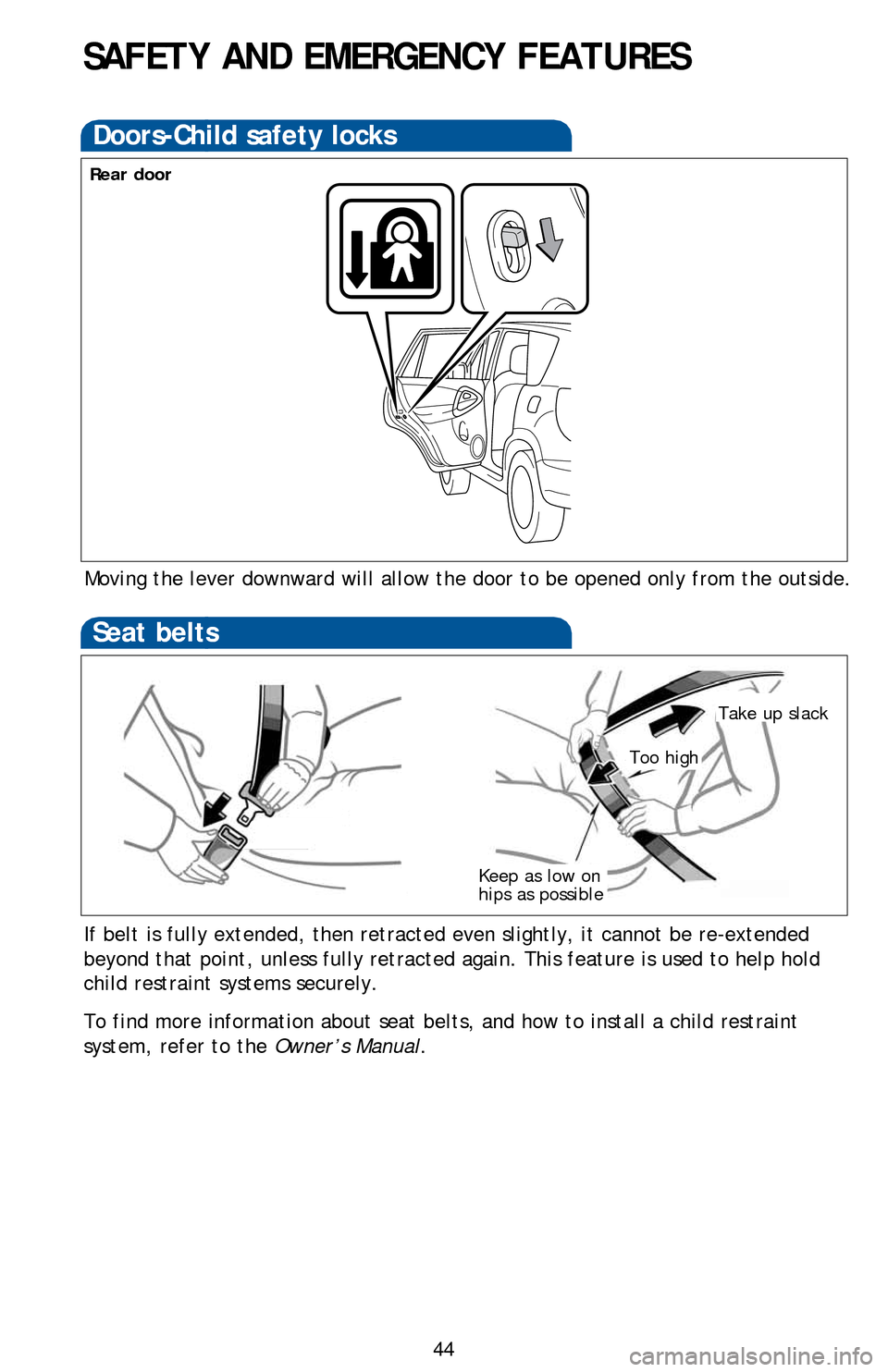
44
SAFETY AND EMERGENCY FEATURES
Moving the lever downward will allow the door to be opened only from the outside.
Doors-Child safety locks
If belt is fully extended, then retracted even slightly, it cannot be re-extended
beyond that point, unless fully retracted again. This feature is used to help hold
child restraint systems securely.
To find more information about seat belts, and how to install a child restraint
system, refer to the Owner’s Manual.
Keep as low on
hips as possible
Take up slack
Too high
Seat belts
Rear door
Page 47 of 52
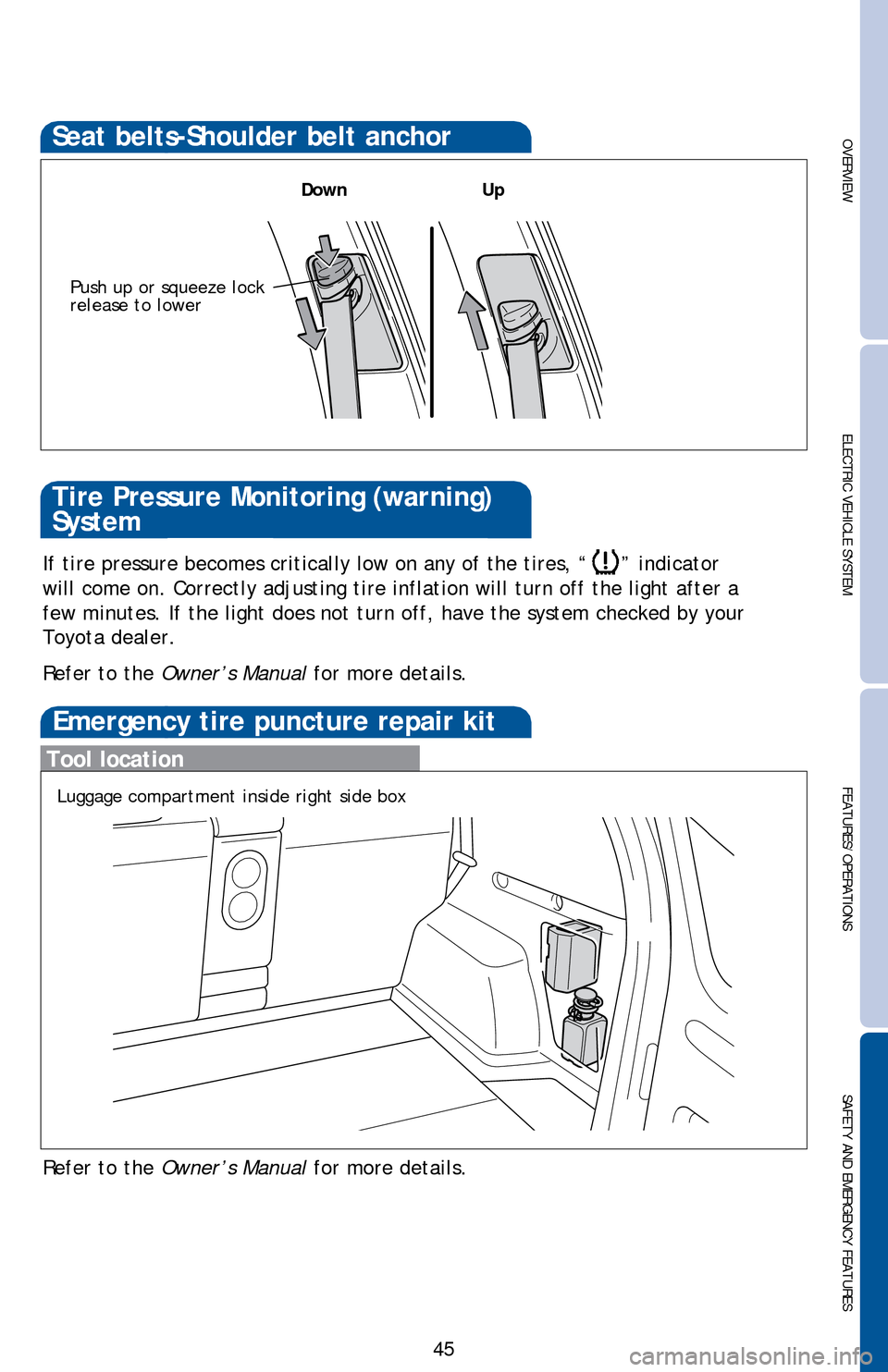
OVERVIEW ELECTRIC VEHICLE SYSTEMFEATURES/OPERATIONS
SAFETY AND EMERGENCY FEATURES
45
If tire pressure becomes critically low on any of the tires, “” indicator
will come on. Correctly adjusting tire inflation will turn off the light after a
few minutes. If the light does not turn off, have the system checked by your
Toyota dealer.
Refer to the Owner’s Manual for more details.
Seat belts-Shoulder belt anchor
Push up or squeeze lock
release to lower
DownUp
Tire Pressure Monitoring (warning)
System
Emergency tire puncture repair kit
Tool location
Refer to the Owner’s Manual for more details.
Luggage compartment inside right side box
Page 48 of 52
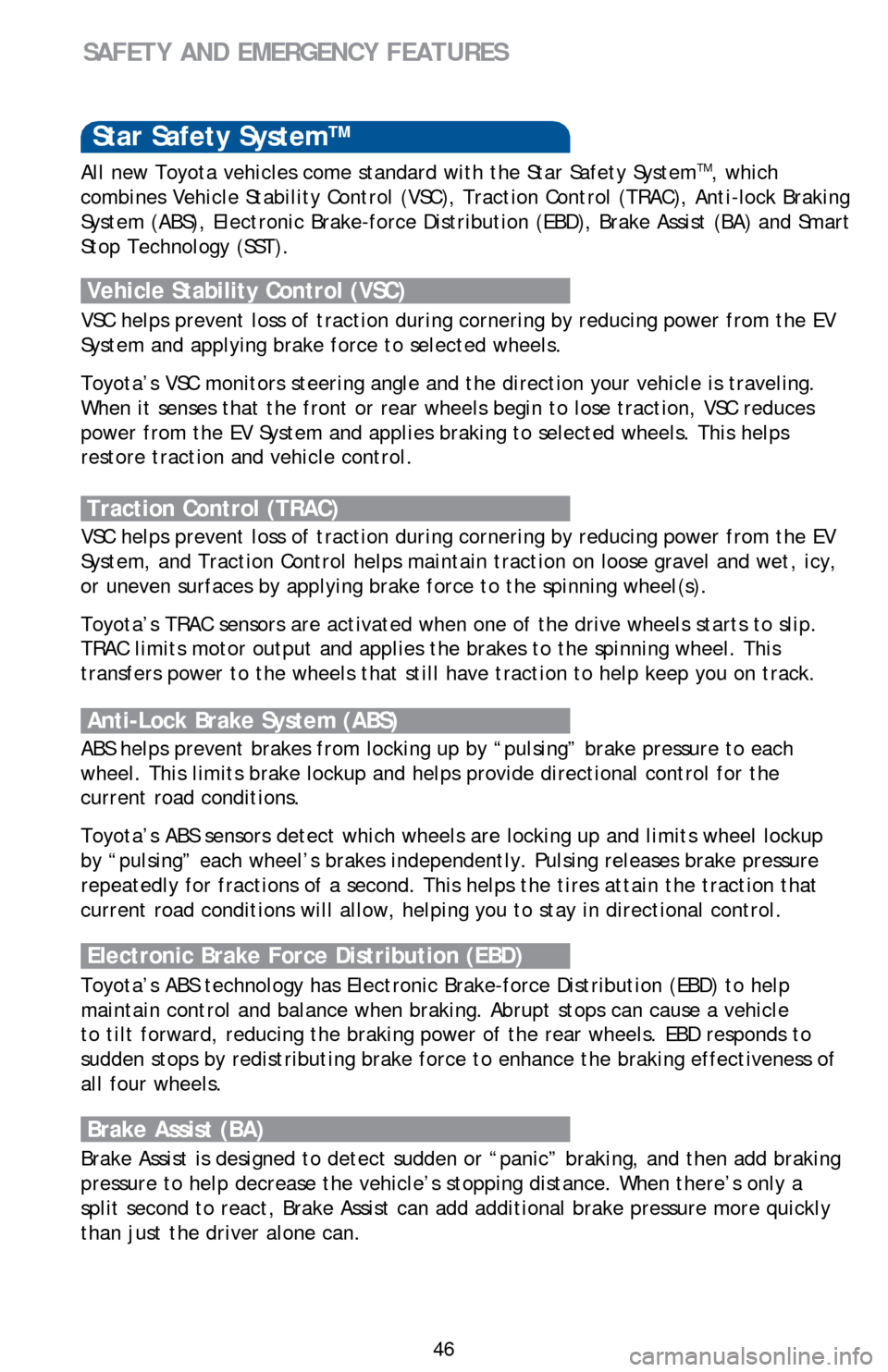
46
Star Safety SystemTM
VSC helps prevent loss of traction during cornering by reducing power from the EV
System and applying brake force to selected wheels.
Toyota’s VSC monitors steering angle and the direction your vehicle is traveling.
When it senses that the front or rear wheels begin to lose traction, VSC reduces
power from the EV System and applies braking to selected wheels. This helps
restore traction and vehicle control.
Vehicle Stability Control (VSC)
Anti-Lock Brake System (ABS)
ABS helps prevent brakes from locking up by “pulsing” brake pressure to each
wheel. This limits brake lockup and helps provide directional control for the
current road conditions.
Toyota’s ABS sensors detect which wheels are locking up and limits wheel lockup
by “pulsing” each wheel’s brakes independently. Pulsing releases brake pressure
repeatedly for fractions of a second. This helps the tires attain the traction that
current road conditions will allow, helping you to stay in directional control.
Brake Assist (BA)
Brake Assist is designed to detect sudden or “panic” braking, and then add braking
pressure to help decrease the vehicle’s stopping distance. When there’s only a
split second to react, Brake Assist can add additional brake pressure more quickly
than just the driver alone can. VSC helps prevent loss of traction during cornering by reducing power from the EV
System, and Traction Control helps maintain traction on loose gravel and wet, icy,
or uneven surfaces by applying brake force to the spinning wheel(s).
Toyota’s TRAC sensors are activated when one of the drive wheels starts to slip.
TRAC limits motor output and applies the brakes to the spinning wheel. This
transfers power to the wheels that still have traction to help keep you on track.
Traction Control (TRAC)
Electronic Brake Force Distribution (EBD)
Toyota’s ABS technology has Electronic Brake-force Distribution (EBD) to help
maintain control and balance when braking. Abrupt stops can cause a vehicle
to tilt forward, reducing the braking power of the rear wheels. EBD responds to
sudden stops by redistributing brake force to enhance the braking effectiveness of
all four wheels.
SAFETY AND EMERGENCY FEATURES
All new Toyota vehicles come standard with the Star Safety SystemTM, which
combines Vehicle Stability Control (VSC), Traction Control (TRAC), Anti-lock Braking
System (ABS), Electronic Brake-force Distribution (EBD), Brake Assist (BA) and Smart
Stop Technology (SST).